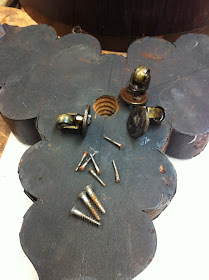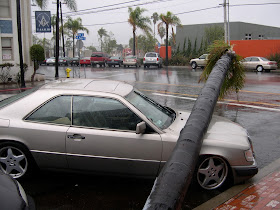 |
| Page 62, "Masterpieces of Marquetry" 1996 |
In 1990 I was hired by the Timken Museum here in Balboa Park to provide public education on the topic of French marquetry. It was funded by the National Endowment for the Arts in conjunction with the San Francisco Legion of Honor as they were rebuilding the museum in SF and needed a place for some of the furniture while they completed construction.
It was a two year contract, and we selected 5 different French cabinets, each one illustrating a different method of marquetry. The name of the show was "France in the 18th century, the Age of Elegance." I provided a 10 minute video, which was nominated for an Emmy, as a documentary. I also installed a Didactic Gallery installation, which included a chevalet, a foot operated frame saw, and all the materials and other hand tools used to make marquetry.
My job required me to lecture in the gallery twice a week for several hours, and, when I was not there the video played on a screen near the "workshop" so visitors could imagine what was involved in creating the marvelous decorative surfaces on display. It was a great job, since my workshop is a few miles from the museum, and I could just ride my bike there, through the park and into the museum where I could change into my work clothes in the guard's room.
Immediately after this contract was finished, I was invited to attend ecole Boulle, in Paris, by Pierre Ramond. Over the next 4 years I became good friends with many students, teachers, and museum conservators in Paris, thanks to the support of Pierre.
On one of my trips, as I walked into the conservation lab at Musee des Arts Deco, I was treated with applause. Surprised at the reception, I asked why they were celebrating my arrival, since they had never done that before. They simply put a copy of Volume II of Pierre's latest book, "Masterpieces of Marquetry" on the table and opened it to page 62.
Imagine my surprise to see a photo of me, sitting on my original chevalet in the Didactic Gallery at the Timken Museum. The copy said "The perpetual transfer of techniques between continents can be illustrated by Patrick Edwards' equipment." (translated from the original French) "After a training period of several months at the Ecole Boulle, this American craftsman built his personal donkey as well as a model for his hometown museum, where he is in charge of furniture restoration."
This was a nice compliment, even if the facts were not exactly correct. In fact, I had spent part of 4 years "in training" at Ecole Boulle. Also, I had built a chevalet some 15 years before I went to study there. Finally, I was not in charge of restoration at the museum, but in charge of public education.
Still, I got the applause from my peers at the museum in Paris, and left the lab walking on air.
I am still working to introduce the chevalet to North American marquetry workers. My efforts at the American School of French Marquetry have been rewarded by all the students who have passed through these doors, and sat on our chevalets. Many dozens of them have purchased the hardware kits and built their own tools.
And now there is a wonderful woodworker, David Clark, who is making the wood parts for the chevalet at a good price, with excellent results. His wood kit is designed to work with my hardware kit, and you can just order it, wait a short time, and put it together with very little effort.
I mentioned his work a few posts ago, so just scroll down to find his information, and see the results.
You can email him directly with your questions or to place your order. Just send it to: david.chevalet@gmail.com
I want to thank him for creating a check list of the parts, and providing names and part numbers for this tool. Now, when I communicate with anyone about the chevalet, we can use the same names for the parts and clearly understand what is going on.
 |
| Click On Picture to Enlarge |
In Pierre's first book, "Marquetry", he illustrated blueprints for the tool, with his parts list.
This tool is measured to be 54cm tall. Pierre notes in his copy that, since the workers today are much taller then they were a century ago, he suggests we add 3 to 5 cm to the plan. Than means the typical French worker would use a tool in the size from 57 to 59cm. Of course, Americans are generally taller then French (my experience), so we have tools as large as 62cm here at the school.
To determine what size tool you would use, just measure (in metric centimeters) from the top of the seat to the base of your throat, while you are sitting comfortably, slightly bent forward.
Since it is absolutely essential that the tool be adjusted to cut perpendicular in both the X and Y axis, you make a test cut to check it, after initial set up or when ever it is taken apart and moved to a new location. Here is the test cut, as shown in Pierre's book:
 |
| Move the Vertical or Horizontal Adjustment Arms until correct |
The test is done with a piece of wood, like tulip poplar, which is easy to cut, and about 1/2" thick. Note that adjustment is usually a combination of the X and Y adjustments, which can take a bit of time. Once it is dialed in, it will be fine for a long time. At any time that the piece you are cutting resists falling out of the packet, it might indicate a need to check the adjustment. Doing this test with a finer blade than the one you are using for the work will increase the accuracy.
Now, for the first time in history, you can order an American Chevalet, made in the USA. I have fulfilled Pierre's wish and transferred the "secret" technology from France to North America.
It only took 20 years!






























